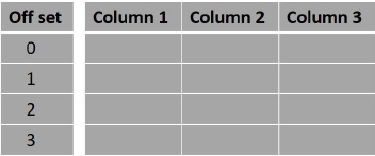impala offset clause
May 26, 2021 impala
Table of contents
In general, the rows in the resultset of the select query start at 0. U sing the offset clause, we can decide where to consider the output. F or example, if we choose offset to 0, the result will be business as usual, and if we choose offset to 5, the result will start on the fifth line.

Grammar
Here's the syntax of biasclause in Impala.
select data from table_name Group BY col_name;
Cases
Suppose we have my_db table called customers in the database database, which reads as follows -
[quickstart.cloudera:21000] > select * from customers; Query: select * from customers +----+----------+-----+-----------+--------+ | id | name | age | address | salary | +----+----------+-----+-----------+--------+ | 3 | kaushik | 23 | Kota | 30000 | | 6 | Komal | 22 | MP | 32000 | | 1 | Ramesh | 32 | Ahmedabad | 20000 | | 5 | Hardik | 27 | Bhopal | 40000 | | 2 | Khilan | 25 | Delhi | 15000 | | 8 | ram | 22 | vizag | 31000 | | 9 | robert | 23 | banglore | 28000 | | 7 | ram | 25 | chennai | 23000 | | 4 | Chaitali | 25 | Mumbai | 35000 | +----+----------+-----+-----------+--------+ Fetched 9 row(s) in 0.51s
You can rank records in the list in ascending order of their ids and limit the number of records to 4 using the limit andorder by clauses, as shown below.
Query: select * from customers order by id limit 4 +----+----------+-----+-----------+--------+ | id | name | age | address | salary | +----+----------+-----+-----------+--------+ | 1 | Ramesh | 32 | Ahmedabad | 20000 | | 2 | Khilan | 25 | Delhi | 15000 | | 3 | kaushik | 23 | Kota | 30000 | | 4 | Chaitali | 25 | Mumbai | 35000 | +----+----------+-----+-----------+--------+ Fetched 4 row(s) in 0.64s
The following is an example of an offset clause. H ere, we get the records in the customers table in the order of id and print the first four rows from line 0.
[quickstart.cloudera:21000] > select * from customers order by id limit 4 offset 0;
When executed, the above query gives the following results.
Query: select * from customers order by id limit 4 offset 0 +----+----------+-----+-----------+--------+ | id | name | age | address | salary | +----+----------+-----+-----------+--------+ | 1 | Ramesh | 32 | Ahmedabad | 20000 | | 2 | Khilan | 25 | Delhi | 15000 | | 3 | kaushik | 23 | Kota | 30000 | | 4 | Chaitali | 25 | Mumbai | 35000 | +----+----------+-----+-----------+--------+ Fetched 4 row(s) in 0.62s
In the same way, you can start with a row with offset 5 and get four records from the customer table, as shown below.
[quickstart.cloudera:21000] > select * from customers order by id limit 4 offset 5; Query: select * from customers order by id limit 4 offset 5 +----+--------+-----+----------+--------+ | id | name | age | address | salary | +----+--------+-----+----------+--------+ | 6 | Komal | 22 | MP | 32000 | | 7 | ram | 25 | chennai | 23000 | | 8 | ram | 22 | vizag | 31000 | | 9 | robert | 23 | banglore | 28000 | +----+--------+-----+----------+--------+ Fetched 4 row(s) in 0.52s